Stirling - Scotland's Heroes
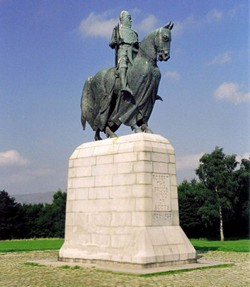
Statue of Robert the Bruce at Bannockburn
more about Robert the Bruce
Stirling is Scotland's smallest city in size, but in every other way it has loomed large in Scotland's history for thousands of years. At the highest point of the Forth River which could be navigated, this city was at the heart of Scotland's struggle for independence.
Like Edinburgh's magnificent castle, Stirling Castle stands high over the city on a rocky outcrop where, for thousands of years, there has been a stronghold of some kind.
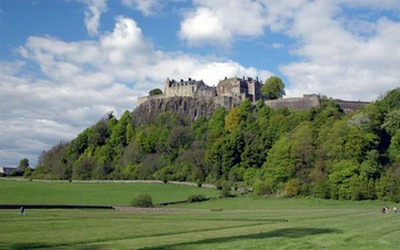
Stirling Castle
Stirling was made a Royal Burgh by King David I in 1130. In 2002, during the celebrations of Queen Elizabeth's Golden Jubilee, and was granted city status.
The town grew up around the castle and is situated between the Ochil Hills and Campsie Fells. It has been that said if you control Stirling you control the entire country. That fight for control is in evidence all around you. From the castle you can see no less than seven battlefields.
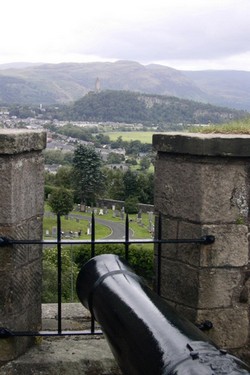
View from Stirling Castle - in the distance the Wallace Monument
In fact the Old Town of Stirling is still protected by the original walls which were built in 16th century to protect Mary Queen of Scots from Henry VIII during that violent part of Scotland's history called the "Rough Wooing", when Henry VIII determined as ever to get his way, tried to get Mary to marry his son.
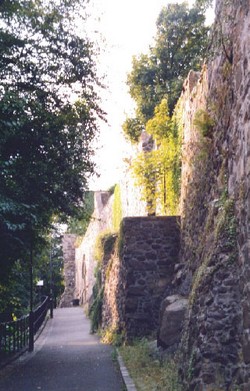
Ancient town walls of Stirling
Stirling Castle dates from the late 14th century, and has been built up over the years on the site of an ancient volcanic plug. It stands 75 metres from the plain beneath. James IV built the Gate House and the Great Hall. Stirling Castle's Medieval Hall is the largest in Scotland.
The last king to live there was James VI who remodelled the Chapel Royal.
The castle is also the site of many hauntings including one of a soldier who has been seen walking out from under these stairs.
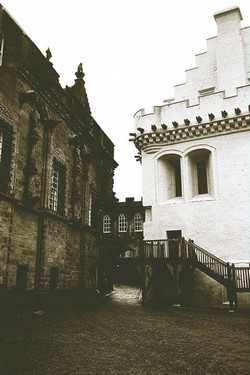
Ghost of soldier seen many times under these stairs at the centre of picture
In 1746 Bonnie Prince Charlie seized control of the town of Stirling, but not the castle..in retaliation his followers blew up the local church of St. Ninians, (where they stored their munitions) of which now only the tower survives.
Two miles south of Stirling is the famous Battlefield of Bannockburn where in 1314, Robert the Bruce, in spite of his enemies' superior numbers, defeated the English under Edward II and sent them scurrying away.
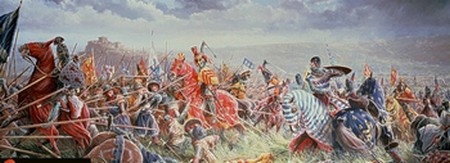
Battle of Bannockburn
Stirling is a region and also the name of the city and it is packed with historical significance. History buffs will find a haven here..
This city was also home to Rob Roy, Scotland's version of Robin Hood, who robbed the rich to help the poor, and he is buried in Balquidder which is nearby in the Loch Lomond and Trossachs National Park which now protects the surrounding forests and wildlife..
more about the Loch Lomond and Trossachs National Park
The Battle of Stirling Bridge in 1297 was also fought here between the English and the legendary William Wallace, recently portrayed in the movie "Braveheart" by Mel Gibson. William Wallace, who was made guardian of Scotland in 1298 and knighted by Robert the Bruce, fought bravely for his country and his inspired career included many successful battles against the English invaders.
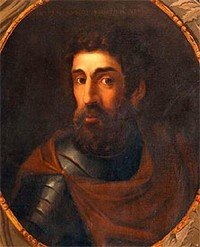
William Wallace
Eventually he went into hiding after his disastrous defeat at the Battle of Falkirk and was finally betrayed in 1305 by a combination of the fickle loyalties of the Scottish nobility, and the overwhelming superiority of the English forces. He was taken to London, where he was tried for treason at Westminster. His horrific punishment, which was carried out at Smithfield in London, was to be hung, beheaded and quartered. He faced his death bravely, even drawing the reluctance admiration of his tormentors.
You can see the 220 feet high monument dedicated to this deservedly famous Scottish hero and legend which stands at Abbey Craig, two miles to the north of Stirling.
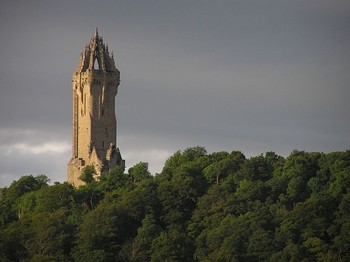
Wallace Monument
William Wallace's two-handed sword is also on display at the Wallace Monument. This was a mighty sword for a mighty legend...

William Wallace's sword
500 years old, The Church of the Holy Rude (another word for cross) is the only surviving church to have held a coronation apart from Westminster Abbey. This is where the Infant son of Mary Queen of Scots was crowned on 29th July 1567 as James VI of Scotland - John Knox performed the ceremony.
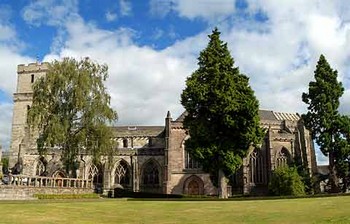
The Church of the Holy Rood
History's hand has written clearly here, and there are musket shot marks from Cromwell's troops clearly visible on the tower and apse.
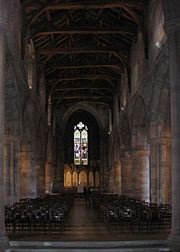
Inside the ancient Church of the Holy Rood
The cobbled streets of the city are populated by students and tourists, creating a cosmopolitan atmosphere. Around 9000 students, representing 80 nationalities, currently study at The University of Stirling.
The winding streets slope down from the castle, and make for a fascinating walk, and you can punctuate your walk by stops at the various local pubs or coffee shops.
Visit the Royal Burgh of Stirling Visitor Centre, which has free admission, to see an exhibition of the city's history which also covers the history and architecture of the castle.
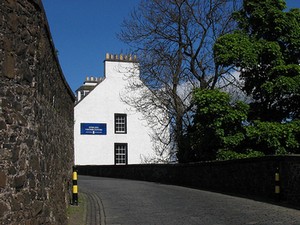
Visitors Centre, Castle Esplanade
Another landmark well worth a visit is the magnificent town house of Willam Alexander, Earl of Stirling, whose home, called Argyll's Lodging at the top of Castle Wynd, has been restored to its former glory. To visit his home is to relive the lavish aristocratic style of this literary Earl.
For someone who loves open top bus tours, City Sightseeing (www.citysightseeing.co.uk) runs a daily tour of the city every thirty minutes from April - October.
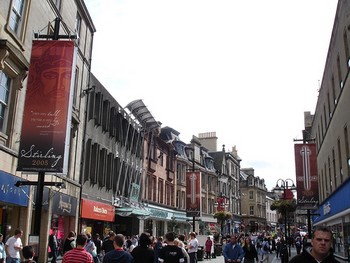
Stirling Town Centre
In and around the city you will find many pleasant places to stay, including the Stirling Highland Hotel at the larger and grander end of the scale, and such welcoming guest houses as Castlecroft Guest House, the Linden Guest House, and Mrs MacGregors for less formal stays.
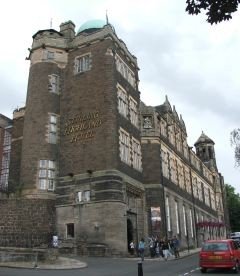
Stirling Highland Hotel
For campers, backpackers and caravanners there are hostels such as the Stirling Hostel, the Willy Wallace Backpackers Hostel, and Witches Craig Caravan Park, all easily accessible from Stirling and all within range of wonderful walks in the nearby Ochil Hills.

Nearby Ochil Hills
Finally here is a map so you can see Stirling's location within Central Scotland and its position alongside Scotland's other major cities and towns..
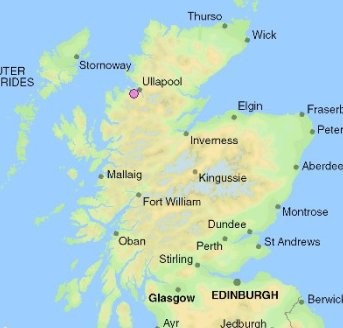
Return to Favourite Places
Return to Home Page





















